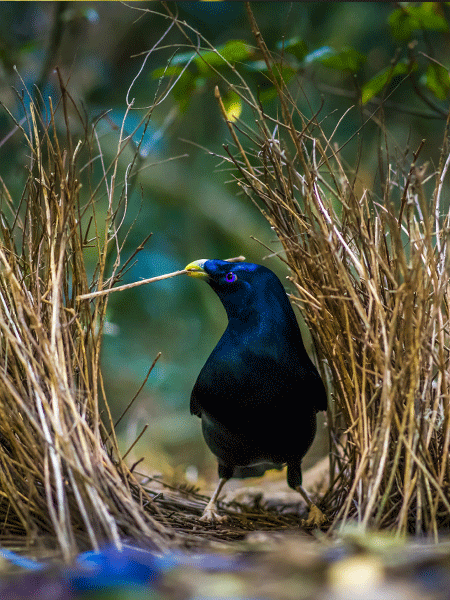– ABOUT
AUSTRALIAN AVIAN GENOMICS INITIATIVE

OBJECTIVES
The Australian Avian Genomics Initiative aims to:
-
-
- Build genomic data for bird conservation: develop data on phylogenomics, reference genomes, and population genetics to support the understanding and conservation of Australia’s unique bird species.
- Advance fundamental bird genomics research: explore key species traits relevant to Australia, including migration, nectarivory, drought tolerance, cooperative breeding, and more.
- Address critical biodiversity needs: use genomics to complement fundamental research and meet the needs identified by society, government, and industry.
-
DATA
For further information and to view and access initiative data, please go to the Bioplatforms Australia Data Portal.
PROJECTS
| Project name | Project Summary | Species name | Data strategy | Project Lead | Partners |
|---|---|---|---|---|---|
| Parrot Genomics Consortium: Forensic genomic toolkit for tracking the illegal wildlife trade | This project will generate genomic data for parrot species to resolve taxonomic uncertainties and create a genetic database to combat the illegal wildlife trade. Using forensic genomic tools, it will support conservation, track trade routes, and aid law enforcement in preventing the trade of endangered parrots. | Papuan Eclectus - Eclectus polychloros macgillivrayi Palm Cockatoo - Probosciger aterrimus macgillivrayi | Reference Genome (HiFi, HiC, ONT), Resequencing (Illumina), Proteomics | George Olah | Australian National University, CSIRO, American Museum of Natural History, National Research and Innovation Agency (BRIN), Indonesia, Research Center for Biosystematics and Evolution (BRIN), Indonesia, Charles Darwin University. |
| Coevolution and speciation in bronze-cuckoos and their hosts | This project aims to study the coevolution and speciation of bronze-cuckoos (Chalcites spp.) by sequencing genomes for Australian and New Guinea species and subspecies. It will identify genetic loci for nestling mimicry, test cospeciation versus host-shift speciation, and explore nestling skin colour evolution. | Little bronze-cuckoo - Chalcites minutillus Bronze-cuckoos - Chalcites sp. | Reference Genome (HiFi), Resequencing (Illumina) | Naomi Langmore | Australian National University, CSIRO. |
| Biogeography of Myzomela species and their parasites | This project will generate a reference genome for the scarlet honeyeater (Myzomela sanguinolenta) to explore its biogeography, blood parasites, and neosex chromosome evolution. The genome will aid in studying parasite-host interactions and sexual differentiation in honeyeaters. | Scarlet honeyeater - Myzomela sanguinolenta | Reference Genome (HiFi, HiC), Resequencing (Illumina) | Sonya Clegg | University of Oxford, Griffith University, QLD Australian Bird and Bat Banding Scheme. |
| Immunogenetics of the Neophema genus | This project will investigate MHC gene deletions in the orange-bellied parrot (Neophema chrysogaster) to assess their role in disease susceptibility, using comparative genomics to guide conservation efforts. | Blue winged parrot - Neophema petrophila Elegant parrot - Neophema chrysostoma Rock parrot - Neophema elegans | Reference Genome (HiFi), Transcriptome (Illumina) | Carolyn Hogg | The University of Sydney, CSIRO, Museums Victoria. |
| Genomics for Malleefowl management | This project uses WGS and DArT data to assess genetic isolation and inbreeding in fragmented malleefowl populations, guiding conservation and climate adaptation. It will also explore mound-building evolution and provide genomic resources for future species management. | Malleefowl - Leipoa ocellata | Resequencing (Illumina), Population genomics (DArT) | Alexandra (Sasha) Pavlova | Monash University, The National Malleefowl Recovery Group. |
| Genomic health and extinction of Australian island birds | This project will investigate the genomic and demographic impacts of island isolation on Australian bird species, focusing on genetic health, divergence, and extinction risk. By examining multiple bird species across various offshore islands, the study will explore the role of harmful mutations and population size in the elevated extinction risk of island birds, providing insights into their genomic vulnerabilities and conservation needs. | multiple | Resequencing (Illumina) | Emily Roycroft | Australian National University, Monash University, CSIRO. |
| Speciation genomics of Falcunculus Shrike-tits | This project will investigate the speciation and genomic divergence of Falcunculus shrike-tits, focusing on their taxonomic distinctiveness and differences in plumage and body size. The results will inform conservation efforts, particularly for the threatened F. whitei. | Western Shrike-tit - Falcunculus leucogaster | Reference Genome (HiFi) | Anna Kearns | CSIRO, Museum für Naturkunde, Australian National University. |
| Speciation genomics in superb and splendid fairy-wrens | This project will explore genomic divergence, gene flow, and phenotypic variation during speciation in the superb and splendid fairywren complexes. By examining the role of geographic barriers and plumage evolution, the project aims to understand how early divergence shapes species development and contributes to the evolution of distinct phenotypic traits. | Superb fairy-wren - Malurus cyaneus Splendid fairy-wren - Malurus splendens | Resequencing (Illumina) | Joshua Peñalba (lead) & Anna Kearns (co-lead) | Museum für Naturkunde, CSIRO, Australian National University. |
| Collection genomics for Top End and Kimberley birds | This project aims to generate reference genomes for avian species from the Kimberley and Top End to address gaps in conservation genetics and taxonomy. By leveraging historical museum specimens and a high-throughput genomic pipeline, the project will enhance species identification, assess genetic diversity, and provide valuable data for conservation management of these remote and biodiversity-rich regions. | Northern Shrike-tit - Falcunculus whitei Partridge Pigeon - Geophaps smithii Chestnut-quilled Rock-Pigeon - Petrophassa rufipennis Kimberley Honeyeater - Territornis fordiana White-lined Honeyeater - Territornis albilineata Rainbow Pitta - Pitta iris Kimberley Flycatcher - Microeca tormenti Lemon-bellied Flycatcher - Microeca flavigaster Sandstone Shrike-thrush - Colluricincla woodwardi | Reference Genome (HiFi), Resequencing (Illumina) | Anna Kearns | CSIRO-Australian National Wildlife Collection and Australian National Insect Collection |
| Genetic basis of plumage divergence in masked and white-browed woodswallows | This project investigates the genetic basis of plumage divergence in White-browed and Masked Woodswallows, focusing on key genes like SOX5 and AXIN1. Using a long-read reference genome for A. superciliosus, the study aims to identify divergent genomic regions and structural variations, providing insights into the genetic mechanisms behind their distinct plumage. | White-browed Woodswallow - Artamus superciliosus Masked Woodswallow - Artamus personatus | Reference Genome (HiFi), Resequencing (Illumina) | Joshua Peñalba (lead) & Leo Joseph (co-lead) | CSIRO, Museum für Naturkunde |
| Genomic Infrastructure for Evolutionary Studies of Australian Parrots | This project aims to expand and standardise genomic resources for Australian parrots, filling critical gaps in evolutionary studies from subfamily to genus levels. By generating reference genomes for key species, we will explore their evolutionary history, speciation, and inform conservation strategies, while fostering collaboration within the Parrot Genomics Consortium. | Parrots - Pezoporus wallicus Clarkona [Psephotellus] varius Psephotellus chrysopterygius or P. dissimilis Purpureicephalus spurius Aprosmictus erythropterus Cyclopsitta coxeni or Cyclopsitta diophthalma Psitteuteles versicolor Glossopsitta concinna Zanda funerea Rainbow lorikeet - Trichoglossus moluccanus Regent parrot - Polytelis anthopeplus Pezoporus wallicus | Reference Genome (HiFi, HiC), Resequencing (Illumina), Population genomics (DArT), Proteomics (tbc) | Leo Joseph/Anna Kearns | CSIRO, American Museum of Natural History, University of New Mexico, Australian National University, Australian Museum, South Australian Museum, Macquarie University. |
| Leveraging genomes for the future of Western Australia's iconic black cockatoos | This project will generate reference genomes for three endangered black cockatoo species in southwest Western Australia, enhancing understanding of genetic erosion and adaptation. The genomic data will inform conservation strategies and improve non-invasive monitoring to protect at-risk populations. | Carnaby’s cockatoo - Zanda latirostris Baudin’s cockatoo - Zanda baudinii Forest red-tailed cockatoo - Calyptorhynchus naso | Reference Genome (HiFi, HiC), Transcriptome (Illumina), Resequencing (Illumina), Population genetics (SNP Arrays) | Sean Buckley | Edith Cowan University, WA DBCA, University of Western Australia, Curtin University. |
| Comparative Genomics of Cockatoos (family: Cacatuidae) | This project will sequence the genomes of 140 cockatoos across 14 species to study evolutionary relationships, demographic history, and trait development. It will also create an SNP panel for forensic testing of illegally traded cockatoos as part of the Parrot Genomics Consortium. | Cockatoo - Cacatuidae | Resequencing (Illumina), Population genomics (ddRAD) | Matthew Lott | Australian Museum, The University of Sydney, Australian National University, Curtin University. |
| Reference genome sequence for the Powerful Owl | The Powerful Owl, listed as vulnerable or endangered in several states, faces threats from habitat loss, fragmentation, and rodenticide exposure. This project aims to develop a draft genome to guide conservation by studying dispersal, habitat responses, and environmental impacts. | Powerful owl - Ninox strenua | Reference Genome (HiFi, HiC), Transcriptome (Illumina), Proteomics (tbc) | Paul A. Haynes | Macquarie University, Federation University, Deakin University, Birdlife Australia. |
| A multi-omics framework for studying regulatory evolution in hybrid Poephila finches | This project explores hybrid incompatibility in Poephila finches by identifying genetic causes of dysfunction between long-tailed and black-throated finches, using experimental crosses and multi-omics approaches to understand speciation and regulatory changes. | Long-tailed finch - Poephila acuticauda Black-throated finch - Poephila cincta | Transcriptome (Illumina, single cell RNA Seq), Resequencing (Illumina), Proteomics (high res MS and label free quantitation (LFQ)) | Oliver Griffith | Macquarie University, American Museum of Natural History |
| A pangenome for the Australian zebra finch | This project will develop a comprehensive pangenome for the zebra finch by sequencing 300 wild individuals across Australia. It will enhance our understanding of population structure, genetic adaptation, and chromosome inversions, improving the species' genomic resource. | Zebra finch - Taeniopygia castanotis castanotis | Reference Genome (HiFi), Transcriptome (Illumina), Resequencing (Illumina), Reference Genome (HiC) | Simon Griffith | Macquarie University, American Museum of Natural History, University of Groningen, East Carolina University. |
| Chromosome inversion evolution in the Australian grassfinches | The Australian grassfinches display notable chromosomal diversity, including inversions that impact speciation and adaptation. This project aims to generate genomic resources to understand chromosomal evolution and support conservation of threatened species. | Poephilinae (family Estrildidae) : - Red-browed finch - Diamond firetail - Pictorella munia - One of painted finch, star finch or plum-headed finch (to be decided) - One species to be decided | Reference Genome (HiFi, HiC), Transcriptome (Illumina), Resequencing (Illumina) | Simon Griffith | Macquarie University, American Museum of Natural History, University of Groningen. |
| Conservation Genomics of Brolga | This project will create a reference genome and population genomic dataset for the threatened south-eastern Brolga, aiding in the assessment of genetic connectivity and resilience to inform conservation strategies and mitigate impacts from windfarm developments. | Brolga - Grus rubicunda | Reference Genome (HiFi), Resequencing (Illumina) | Lauren C White | Arthur Rylah Institute, Macquarie University, Kumming Institute of Zoology, Agriculture Victoria, DEECA Biodiversity Division |
| Population genetics and viromics of shearwaters | Wedge-tailed and short-tailed shearwaters are declining seabirds, with concerns about their genetic diversity and potential as disease vectors. This study will analyse their population genomics and viromes to assess their adaptations and viral risks. | Short-tailed shearwater - Ardenna tenuirostris Wedge-tailed shearwater - Ardenna pacifica | Reference Genome (HiFi), Resequencing (Illumina), Population genomics (DArT), Viromics | Jane Younger | University of Tasmania |
PARTNERS
hide
Strategic partners
advisory committee members
CONTACT US
Project Manager
Sophie Mazard – Bioplatforms Australia
smazard@bioplatforms.com
Science Lead
Anna Kearns – Australian National Wildlife Collection, CSIRO
anna.kearns@csiro.au
General Manager
Sarah Richmond – Bioplatforms Australia
srichmond@bioplatforms.com
